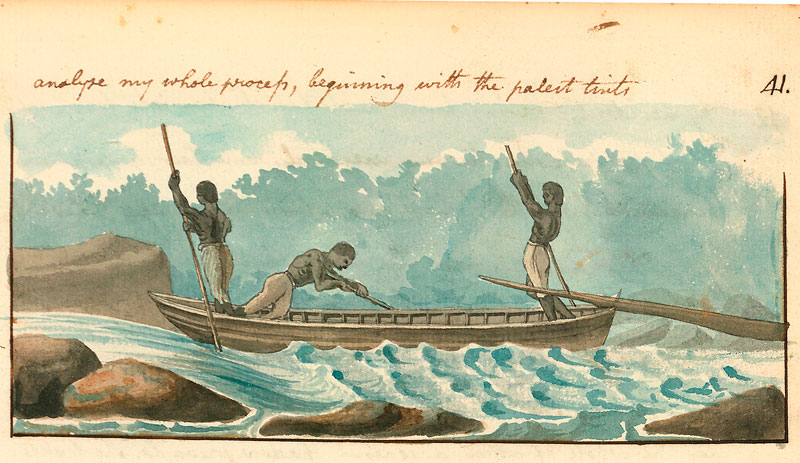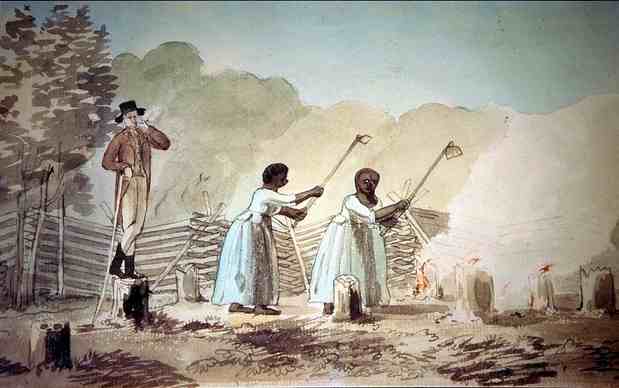
T.H. Breen reviews Philip Morgan's book "Slave Counterpoint" on 19 July 1998, in the New York Times -- In 1754 an American tobacco planter residing in England decided to send his slave Aron back to Virginia. Joseph Ball expressed great concern for Aron's welfare, instructing white overseers in the colony to provide the slave with a ''framed House,'' a sturdy bed and a selection of ''Household Goods.'' Ball even promised Aron ''the Liberty of a Horse to Ride to Church.'' But no sooner had Aron landed in Virginia than his ''Loving Master'' announced in a letter that if the slave ever seemed ''unruly,'' he ''must be tyd up and Slasht Severly, and pickled'' (to be pickled was to have salt and vinegar rubbed into one's wounds).
In ''Slave Counterpoint'' Philip D. Morgan builds curious fragments of experience, like Aron's tale, into a massive reconstruction of life in the 18th-century American South. He touches on an impressive range of topics: the material culture of plantations, patterns of work, contacts between whites and blacks in commerce, recreation, worship and sex. Most important, he helps us understand how African-Americans caught up in a web of interdependencies made sense of their lives, not as slaves but as human beings.

This was a world of irreconcilable contradictions. In encounters with whites, black people who were defined as chattel insisted on recognition of their humanity. In this society, no one escaped from slavery's pervasive grip. The plantations in the Chesapeake Bay counties of Virginia and the Lowcountry areas of South Carolina lying nearest to the oceanfront were scenes of constant negotiation, perpetual struggles between body and soul, as masters and slaves, blacks and whites, men and women tried to comprehend an all-embracing labor system that was ''no curious abnormality, no aberration, no marginal feature of early America.'' The originality of this study derives from Morgan's utterly persuasive -- and deeply disturbing -- contention that slavery was ''a fundamental, acceptable, thoroughly American institution.''
As the character of colonial slavery evolved, so did patterns of race relations. Morgan distinguishes three stages of development. Encounters that occurred in the 17th century, for example, were strikingly different from those of the Revolutionary era. White settlers in early Virginia adopted slavery with muted enthusiasm. European indentured servants made up a much larger percentage of the labor force than did Africans. Personal contacts between the two groups tended to be more open, more fluid. Black slaves and indentured whites frequently ran away together and on several occasions resisted Virginia authorities with force of arms.

But during the early decades of the 18th century the demography of the American slave societies suddenly shifted. In both Chesapeake Virginia and Lowcountry South Carolina an insatiable appetite for field workers triggered a flood of new slaves, most of whom came from Angola, the Bight of Biafra and Senegambia. These Africans -- overwhelmingly young males -- whose cultures and languages the whites could not understand, frightened the planter class, and the colonial gentry moved decisively not only to discipline an exploding slave population but also to discourage informal relations between the races.
During the third phase of slave development, the two regions took sharply divergent paths. By the mid-1700's Virginia planters no longer relied on a supply of laborers imported directly from Africa. The reasons for this shift were complex. An improvement in life expectancy coupled with a more balanced sex ratio allowed slaves more easily to find mates and to produce a large mixed population. Chesapeake blacks paid a cultural price for the opportunity to form families, however, for with each passing year African-Americans found it harder to sustain the Old World customs and languages of their parents. The Lowcountry followed a different course. Throughout the century rice plantations continued to absorb thousands of new slaves, many of whom died within a year of arrival. On the eve of the American Revolution, 35 percent of the slaves of South Carolina were Africans, while in Virginia only 9 percent of the blacks had experienced the infamous Middle Passage.

From "Slave Counterpoint": "An Overseer Doing His Duty Sketched From Life Near Fredericsburg," by Benjamin Henry Latrobe, 1798.
The quality of material life depended a lot on where the slave lived. Morgan recognizes that comparisons of this sort raise hard interpretive problems. After all, enslavement is objectionable in any form. But he brings subtlety and common sense to sensitive issues. An African-American working in the Chesapeake colonies was most likely better fed, clothed and housed than a slave in the Lowcountry. The explanation for different treatment has almost nothing to do with generosity of spirit. Masters in both regions wanted to maximize returns on capital investment. It was just that in rice-producing areas potential profits were much larger than in the tobacco colonies. The great planters of South Carolina thought nothing of sending gangs of Africans to labor in extremely unhealthy conditions. Some slaves survived, many died; all could be replaced. But in the Chesapeake, amortizing an initial expenditure took much longer, and it made good financial sense to attend to the slaves' diet and health. The irony was that the continuing influx of new slaves into the Lowcountry, combined with the large concentrations of field hands on rice plantations, meant that African culture, if not individual Africans, survived much longer in South Carolina than in Virginia. The conditions of work may have been horrendous, but as Morgan explains, ''Rice cultivation provided Lowcountry slaves with greater autonomy, more residential stability and a chance to incorporate more African practices into their work routines than tobacco cultivation did for Chesapeake slaves.''
During the early decades of the 18th century, masters of large Southern plantations expressed not the slightest defensiveness about denying freedom to thousands of slaves. White colonists often adopted the language of the Old Testament, depicting themselves as ''the Patriarchs of old.'' The great planters assumed absolute power over their slaves, and when one of these self-styled fathers concluded that a black laborer had challenged his authority -- by running away, for example -- patriarchal concern for the worker's well-being could turn vengeful. Robert (King) Carter, Virginia's wealthiest tobacco planter, cut off the toes of slaves who repeatedly attempted to escape. And no white contemporary in that region criticized such drastic punishment. No wonder that when George Ogilvie established a plantation on the Santee River in 1774, he imagined himself ''like the Tyrant of some Asiatick Isle the only free Man in an Island of Slaves.''

By the end of the century, however, declarations of naked power embarrassed even hardened slaveholders. Perhaps as a result of the spread of evangelical Protestantism throughout the South, masters felt obliged to proclaim their sincere attachment to the slaves. African-American workers, they claimed, were members of extended plantation communities -- in the words of one master, objects of ''domestic affection.'' When slaves resisted, masters whined that the blacks ''don't love me.'' In fact, in a stunning display of hypocrisy, some white paternalists accused rebellious slaves of ingratitude. In 1803 Benjamin Smith, a South Carolinian, pleaded his case against Bristol, a slave who had run away. ''He has now left my service without the slightest provocation,'' Smith cried, ''without having ever been whipped in it, without undergoing the most laborious and disagreeable part of duty.'' With great reluctance he offered a $50 reward literally for Bristol's head.
However the masters justified their actions, the slaves took advantage of whatever opportunities for personal independence came their way, accommodating themselves to the incessant demands of the dominant culture while preserving memories of an African past. They enjoyed partial victories. Against extraordinary odds black people in the Chesapeake and the Lowcountry managed to create families, and in their courageous insistence on reaching out to loved ones, they forced masters to recognize their humanity. Morgan, a professor of history at the College of William and Mary, set out to provide ''a balanced appreciation for the oppressiveness of bondage and of the ability of slaves to shape their lives.'' He has succeeded splendidly, and in the process reminded modern readers that the world of the 18th century is not so distant as they sometimes imagine. (source: New York Times)
Philip Morgan: Early American Slave Culture
Philip Morgan: Early American Slave Culture from The Gilder Lehrman Institute on Vimeo.

Excellent review. Enjoyed it.
ReplyDeleteThis comment has been removed by a blog administrator.
ReplyDeleteI think we should all own a African American or a bunch of them, its the white way.
ReplyDeleteThis comment has been removed by the author.
Deleteracist will burn.......for eternity..
DeleteThis comment has been removed by the author.
ReplyDeleteHi! I was just wondering about the book or the place from where you took the picture with the men rowing on the little boat. I would like to find it. Tks in advance!
ReplyDeleteوهي اخر فترة من مدد عملية نقل الأثاث، والتي تعتمد عليها مؤسسة لنقل الأثاث، بواسطة مندوبين مدربين ومتخصصين في عملية تركيب الأثاث مرة اخرى عقب فكه باستعمال المعدات الجديدة المخصصة بهذا، والاطمئنان عليه اثناء التركيب، فهي المسئولة على اصلاح أي تلف تعرض له الأثاث اثناء عملية النقل وايضا تقدم خدمة إضافية وهي تطهير العفش وهذا بطلب خدمة خدمة تطهير بيوت
ReplyDelete.
شركه نقل عفش من الرياض الى ابها
شركه نقل اثاث من الرياض الى ابها
شركه نقل عفش
Thanks for sharing such an amazing content. Really loved to read such content. Keep posting such content in future as well.
ReplyDeleteIPVanish Crack
Brave Browser Crack
CCleaner Pro Crack
Visual Studio Crack
Visuino Crack
World Machine Crack
DslrBooth Crack
StarUML Crack
thank for content about Early American Slave Culture href="https://joker-slot.vip/demo-slot/"> JokerSLot
ReplyDelete"dogsblueprint.com content is a testament to their passion for our four-legged friends."
ReplyDeletePhilip Morgan's exploration of early American slave culture offers profound insights into the complexities and legacies of majhinaukris this historical period, shedding light on its lasting impact on society. His research contributes significantly to understanding the nuanced experiences of enslaved individuals and their enduring cultural contributions.
ReplyDelete
ReplyDeletePhilip Morgan's exploration of early American slave culture offers profound insights into the complexities and legacies of this historical period, shedding light on its lasting impact on nicephrase society. His research contributes significantly to understanding the nuanced experiences of enslaved individuals and their enduring cultural contributions.
Highly impressed with the innovative approach mcheights.com takes to construction projects. They bring fresh ideas to the table while maintaining quality.
ReplyDelete
ReplyDeleteEarly American slave culture was shaped by the harsh realities of slavery, leading to the development of unique cultural practices among enslaved people. Despite oppressive conditions, they created rich traditions and strong community bonds through music, religion, and family life.
The flavors of terea heets dubaii are refreshing and diverse.
ReplyDeleteI had no clue that pitbull puppies for sale needed different training methods. Very insightful.
ReplyDeleteGreat points! http://wkhtmltopdf.com is lightweight and perfect for backend integrations.
ReplyDelete